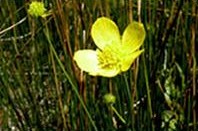Ranunculus acriformis
| Ranunculus acriformis | ||||||||||||
|---|---|---|---|---|---|---|---|---|---|---|---|---|

Ranunculus acriformis var. Aestivalis |
||||||||||||
| Systematics | ||||||||||||
|
||||||||||||
| Scientific name | ||||||||||||
| Ranunculus acriformis | ||||||||||||
| A.Gray |
Ranunculus acriformis is a species of the buttercup family.
description
The stems are erect, bristly or hairy striegel, not the Nodien rooted and not bulbous at the base. The roots are never knotty. They can sometimes be thickened and more or less fleshy. The base leaf blade is broadly ovate to heart-shaped, its outline can occasionally also be kidney-shaped. They are 2.2 to 6 × 2.5 to 7.7 (rarely up to 10) centimeters in size and deeply tripartite or sometimes tripartite. The last leaf segment is linear to broadly linear. The leaf margin is entire, the end of the leaf pointed or rounded-pointed.
The prescription is hairless. The sepals are 4 to 6 × 2 to 4 millimeters in size, spread out or bent back to different degrees and covered with hair. The mostly 5, rarely up to 10 petals are 7 to 13 × 4 to 10 millimeters in size and yellow. The heads of the achenes are 5 to 8 × 6 to 8 (rarely up to 10) millimeters and spherical or hemispherical. The achenes are 2.2 to 3.4 × 2 to 3 millimeters in size and hairless, the edge forms a narrow, 0.1 to 0.2 millimeter wide rib. The beak is 0.4 to 1.6 millimeters long, permanent, lanceolate and strongly curved.
Occurrence
Ranunculus acriformis occurs in western North America.
Systematics
Ranunculus acriformis was first described by Asa Gray in 1886 . There are three varieties:
- Ranunculus acriformis var. Acriformis
- The stems are curly haired. The prescription is spherical or cylindrical. The sepals are spread out or bent back from the base and hairy strongly pressed. The petals are 7 to 9 millimeters in size. The beak is 1 to 1.2 millimeters long. The number of chromosomes is 2n = 28. The flowering period extends from May to July. This variety is found in southeastern Wyoming and northern Colorado. It grows on moist grassland at altitudes of 1,800 to 2,800 meters.
- Ranunculus acriformis var. Aestivalis L.D. Benson
- The stems are wire-haired. The recipe is inverted pear-shaped to cylindrical. The sepals are bent back about 2 millimeters above the base and fluffy due to the spreading hair. The petals are 8 to 11 millimeters in size. The beak is 0.4 to 1 millimeter long. The flowering period extends from July to September. This variety is only known from two locations in Utah. It grows on grassland at altitudes of 2100 to 2900 meters.
- Ranunculus acriformis var. Montanensis ( Rydberg ) LD Benson
- The stems are wire-haired. The recipe is spherical to hemispherical. The sepals are bent back 1 to 3 millimeters above the base and fluffy due to the spreading hair. The petals are 7 to 13 millimeters in size. The beak is 1.2 to 1.6 millimeters long. The flowering period extends from May to August. This variety is found in southwest Wyoming, western Montana, Idaho, and Utah. It grows in moist grassland.
supporting documents
- Alan T. Whittemore: Ranunculus acriformis . In: Flora of North America. Vol. 3 . on-line
Web links
- Distribution map of Ranunculus acriformis var. Acriformis in the Flora of North America
- Distribution map of Ranunculus acriformis var. Aestivalis in the Flora of North America
- Distribution map of Ranunculus acriformis var. Montanensis in the Flora of North America